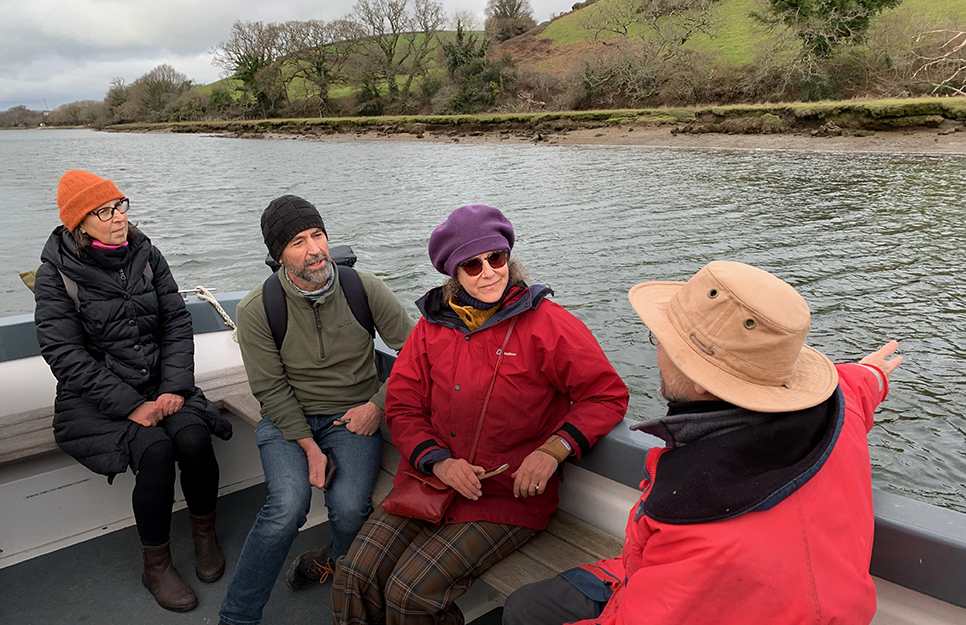A conversation with Nigel Mortimer, Estuaries Officer at South Devon National Landscape. Nigel is a key member of the project team for Living Dart: The Saltmarsh Project.
Tell us a bit about your background and how you acquired all this knowledge about saltmarshes
I grew up watching Jacques Cousteau on television and always wanted to do marine biology, so I learned to dive on the first birthday that I was allowed to, then I studied Marine Biology and Ecology at university and I have always found work that makes the most of that knowledge.
What role is South Devon National Landscape playing in The Saltmarsh Project?
We have an interest in sustainable and conservation management of the Dart Estuary and our role in the project is to share knowledge on the ecology of the saltmarshes and how they work, and to help interpret their workings and specialness.
So how do Saltmarshes work?
Well, if you consider the foreshore–the area that’s covered and uncovered by the tide– saltmarshes occupy the niche right at the top of that. It’s a very narrow little niche as well. Here’s the funny thing: a lot of people think of saltmarshes as having to be covered by every tide, but if an area of foreshore is covered by every tide it tends to be a habitat dominated either by seaweeds or mudflats and if–it’s rough enough–marine animals such as limpets and barnacles.
So, saltmarshes occupy the area right at the top of the foreshore, which are covered by tidal waters either most days or very occasionally. They are home to land plants, rather than seaweeds, which have adapted all these wonderful adaptations for being able to cope with the salt. If it’s not salty enough, land plants proper will be able to out-compete them because they’re just a bit more aggressive. Whereas if there’s salt there, the salt is toxic to most plants, so it kind of pushes the land plants back and allows the saltmarsh plants to flourish.
And why do the Dart Estuary’s saltmarshes need our attention?
We are concerned that they’re diminishing in health and extent, through the cumulative impact of our human activities and misunderstanding, and possibly climate change. We are increasingly realising their worth in terms of carbon sequestration and very long-term lock-out/storage, so on top of restoring saltmarshes to where we think we once had them, we’d like to enhance the existing saltmarshes where we can too.
What kind of human activities or misunderstandings are having a negative impact?
There are lots of angles to this answer really. But one of the issues for saltmarshes is–unless you recognise what you’re looking at–they don’t always look like much and are overlooked. People often see them every day but don’t realise that there’s something so special about them. The poster child of saltmarshes in our area is the sea aster, its flower looks a bit like a purple michaelmass daisy in the summer months. But most of the time a lot of the saltmarsh is covered in grass. Also, one of the ways that saltmarshes adapt to the salt is to get through their whole lifecycle very quickly before the salt has a chance to kind of knock them back. So, over the winter, they die back and all you might see is loads of dead plants.
One of the things that makes saltmarshes so special in terms of their ecosystem services is what they do for us: they trap very significantamounts of carbon and take some of that down into their own roots and the sediment. ou’ve also got the river flowing down from its catchment carrying a runoff of soil and detritus–the organic matter from the leaves and living things.– Then as it’s an estuary, you’ve also got a lot of natural detritus coming in with the tides from the sea as well. And asthe saltmarsh is sticking up out of the bed, it slows the energy of the water and a lot of that material slows and ‘snows’ down onto the surface. So you get this double whammy of organic carbon being trapped within the sediment … for, tens, hundreds and even thousands of years. Unfortunately, because they’re so good at trapping all this natural debris, they’re also very good at trapping rubbish, so they can look like very trashy places.
Most of the estuaries in the Southwest are what we call ‘ria-type estuaries’ or drowned river valleys. A feature of these is that they have very steep sides, which makes our saltmarshes very narrow–they form at, and beyond, the upper foreshore, as that’s the only place they can be. This little narrow strip of saltmarsh is exposed to all the energy and everything that’s happening around it. In busy estuaries, where there are boats plying up and down,and too much wake, the waves can erode the banks. There might also be footpaths, people dragging their boatsandsaltmarshes are softer than stone so people store their boats on top of them. This kind of human activity is a lose-lose for the poor saltmarsh – death by a thousand nibbles.

Thanks to the interest in blue carbon, the wider community are realising just how crucial saltmarshes are because they lock away carbon for so long. But most people don’t realise that and may trash them in their ignorance, which is understandable. One of the difficulties that we have with our project, is that we’re telling people just how lovely and wonderful the saltmarshes are. We want people to get to know them but we don’t want them so close that they’re actually standing on the saltmarshes and unintentionally doing damage to the very thing that we’re asking them to treasure, respect and look after. We don’t want anybody to feel guilty about these things, but at the same time, we’re trying to build understanding to get people to treasure them. And where possible we want to conserve, enhance and, in some places, restore them. And part of that process is helping people to understand what we’re trying to doand encouraging them to help us keep the saltmarshes that way.
What role is climate change playing in the degradation of saltmarshes?
As well as plants, saltmarshes support some rather interesting wildlife that has adapted to the salt. There are a lot of salt-tolerant insects that you don’t normally see further down the shore. One of the issues with climate change is when the sea level rises the saltmarsh would ideallymigrate up the foreshore with the rise. But in a built environment, where there is a wall or something, we’ll see what’s called ‘habitat squeeze’. The saltmarsh will rise to a point where it can’t get back any further but the sea level will keep rising, so the saltmarsh will get narrower and narrower until there’s potentially none left. And in the Dart Estuary where we’ve historically built over so much land. We’ve had a huge influence on the landscape and this is one of the impacts.
How will you go about enhancing or restoring them?
Our approach is multi-staged. The Bioregional Learning Centre has arole of awareness raising and involving the community. Devon Wildlife Trust is in conversation with landowners about how best they might manage the land behind. Devon Biodiversity Records Centre has surveyed some the saltmarshes, looking at their health and extent and trying to gauge what’s happening there. FiveRivers and the UK Centre for Ecology & Hydrology will then take those surveys and considerwhat could be done in terms of conservation, enhancement and restoration. For some saltmarshes that will mean trying to prevent the harmful factors so that they can then take care of themselves. In other places maybe a landowner might take away a barrier so that the saltmarsh can rise naturally with the sea level as the climate changes, or maybe we can do introduce some management options: put buffers in the way soften the wake of waves, maybe control or reduce grazing, where there’s too much or little things like maybe even replanting.
And then there’s a few places for which there are some lovely historic maps of the Dart taken before the last war, which we can compare to satellite images to see where the saltmarsh has gone. We wouldn’t want to put saltmarsh back where it might just get eroded away again, but we might have options for doing some reasonably-sized activities where we might put in wooden stakes in the mudflats, weave them with branches and then build it up with organic material that encourages siltation behind it. Or if somebody is dredging an area within the estuary, we might use that sediment to shore up the foreshore up, up to a level that saltmarsh would thrive naturally , or we could maybe replant the saltmarsh. But I favour creating the right conditions so that the saltmarsh can look after itself.
What constitutes ‘active and responsible care’? What are the main things people need to know and what actions can they take to protect these habitats?
Starting with being on the water, if you’re on any kind or size of boat: be aware of where you are, watch your wake, and watch where you land or picnic. If it’s a really high tide, make sure you don’t drive your boat over the top of it. Even if you’re on a paddleboard or kayak, make sure that your paddle isn’t disturbing the bottom or the saltmarsh. I paddle myself and I know that one paddle hit on the bottom is neither here nor therebut the problem is the cumulative impact of many small hits. We don’t need to beat ourselves up if it happens, as long as we’re just trying to do our best. Also, we’re asking people to be sensitive to where they’re launching and retrieving their paddle boards, where they’re stopping for lunch, where they’re paddling. It’s also the big obvious stuff like things like taking litter home.
From the land in the immediate vicinity of a saltmarsh, it’s a question of people being aware of where they’re walking because very often the saltmarshes are built on relatively soft mud so even a small amount of trampling will cause harm. Again, if one or two people do this it’s not the end of the world but if it becomes a footpath then it becomes an issue. Also, it’s important that landowners recognise where they might have saltmarshes and play a part in conserving them.
Then for all of us living, working and playing within the water catchment, it’s a case of doing what we can for water quality. We all need to go to the toilet and it’s the job of water companies to break that down. So, there are necessarily ‘nutrients’ within the system. But what we don’t need to do is put the remnants of our meal down the kitchen sink. Another problem can be the overuse of fertilisers we might put on our gardens – most farmers know the score by now. All of these things add up, so it’s a case of being aware and doing the best we can to avoid contributing.

